Cruise ship docking procedures: Difference between revisions
No edit summary |
No edit summary |
||
| Line 10: | Line 10: | ||
There are several procedures that must be followed to ensure the safe arrival of a cruise ship: | There are several procedures that must be followed to ensure the safe arrival of a cruise ship: | ||
===Clearance=== | ===Clearance=== | ||
Cruise ships must obtain proper authorization before entering Venice's waterways. The information used to be processed by hand (using paper), which was usually collected by a representative from the [[Capitaneria di Porto]]. However, most ports now keeps track of all the information on ships through the | Cruise ships must obtain proper authorization before entering Venice's waterways. The information used to be processed by hand (using paper), which was usually collected by a representative from the [[Capitaneria di Porto]]. However, most ports now keeps track of all the information on ships through the Logistics Information System (an interactive computer database which port officials use to keep track of transiting ships' logistical needs). | ||
===Pilots=== | ===Pilots=== | ||
After a cruise ship obtains proper clearance, a pilot is sent out to properly navigate the ship through the | After a cruise ship obtains proper clearance, a pilot is sent out to properly navigate the ship through the Giudecca Canal. It usually takes about 30 minutes or so for the pilot to reach the cruise ship (from the Marittima). After reaching the ship, it takes the pilot about 45 minutes to make it to the Marittima. However, there are also two other port facilities, San Basilio and Riva Sette Martiri, that a cruise ship may dock. | ||
===Dockers=== | ===Dockers=== | ||
Revision as of 11:58, 9 December 2012
Cruise ships must go through several procedures when entering the city of Venice.
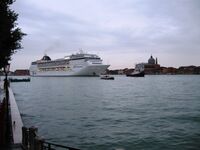
History
Cruise ships have been visiting in Venice for decades. The docking procedures for cruise ships entering Venice haven't undergone any dramatic changes over the years. The only procedure that has changed over the years is the level of security that passengers must pass through when disembarking and boarding the ship.
Goal
The goal of the cruise ship docking procedures is to properly ensure the safe arrival of the cruise ship passengers, the ship itself, and (ultimately) the safety of the city of Venice.
Procedures
There are several procedures that must be followed to ensure the safe arrival of a cruise ship:
Clearance
Cruise ships must obtain proper authorization before entering Venice's waterways. The information used to be processed by hand (using paper), which was usually collected by a representative from the Capitaneria di Porto. However, most ports now keeps track of all the information on ships through the Logistics Information System (an interactive computer database which port officials use to keep track of transiting ships' logistical needs).
Pilots
After a cruise ship obtains proper clearance, a pilot is sent out to properly navigate the ship through the Giudecca Canal. It usually takes about 30 minutes or so for the pilot to reach the cruise ship (from the Marittima). After reaching the ship, it takes the pilot about 45 minutes to make it to the Marittima. However, there are also two other port facilities, San Basilio and Riva Sette Martiri, that a cruise ship may dock.
Dockers
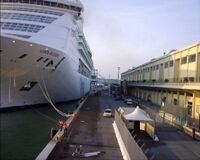
Once the Pilot drives the boat close enough to the dock, members from the cruise ship toss down small lines to the dock workers. Once the dockers grab the small line, the members on-board the cruise ship start reeling down the larger lines, which are connected to the small lines. After enough line has been reeled out, the dockers properly secure them to the dock. They repeat the process for several positions along the side of the ship to ensure the ship is properly secured to the dock.
Security and Customs
After a cruise ship has been properly docked, disembarking passengers must pass through designated security terminals. The passengers will have to go through a customs checkpoint where their luggage will be checked to ensure it is safe to enter the city. The passengers must also pass through a passport control checkpoint to make sure the passenger is allowed to visit the city/country and is indeed who he/she says they are.
Port Facilities
There are three port facilities in Venice that allow cruise ships to dock: the Marittima, San Basilio, and Riva Sette Martiri.
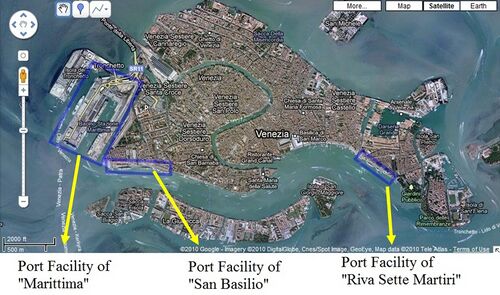
Marittima
The main port facility in Venice is the "Marittima." A cruise ships is docked in one of the 6 primary zones in the Marittima: 18, 20, 107, 110, 117, and 123. This is where most cruise ship passengers will pass through when visiting Venice.
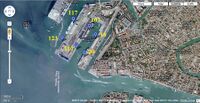
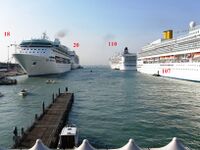
San Basilio
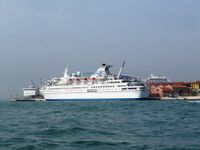
The port facility of "San Basilio" serves two primary purposes. First, the port is used for holding cruise ships that have been impounded by the city or require more laborious maintenance. A cruise ship is impounded when it is has been found to be unfit for operation. This could be because the ship's emissions are in violation of environmental codes, the living conditions are not up to current health codes, the ship did not provide proper paperwork/clearance before arriving in Venice, or the ship is in violation of some law or regulation. The Capitaneria di Porto inspects each cruise ship that arrives in Venice, in conjunction with the Venezia Terminal Passeggeri, and determines when a cruise ship needs to be impounded. The impounded ships are held in Venice until the ship corrects whichever violations have been made and the ship becomes fit for operation once again. Secondly, San Basilio is used as an overflow when the Marittima gets full.
Riva Sette Martiri
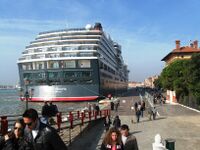
The third port facility in Venice, Riva Sette Martiri, is used primarily as an overflow for cruise ships when the Marittima and San Basilio are full. However, it is also used for ships like the Queen Victoria that are in-transit. This means that the cruise ship is only stopping to visit Venice, opposed to performing a turn-around operation, which is when all the passengers disembark the cruise ship and new passengers get on. However, the Venice Terminal Passeggeri tries to avoid docking ships here because there is no real "facility" here, which makes it harder to perform maintenance on the ship, restock supplies, and have passengers go through proper security screenings. Also, the Venice Terminal Passeggeri must set up fences/gates before the ship arrives so that the passengers pass through the proper security checkpoint(s).
External Links
- Venezia Terminal Passeggeri
- Venice Port Authority
- Capitanerie di Porto-Guardia Costiera
- Capitanerie di Porto-Guardia Costiera-Venezia
References
Zanforlin, Marco. Venezia Terminal Passeggeri (R.S.P.P/P.F.S.O./A.Q.). Interview conducted by Chris O'Brien. 27 October 2010.